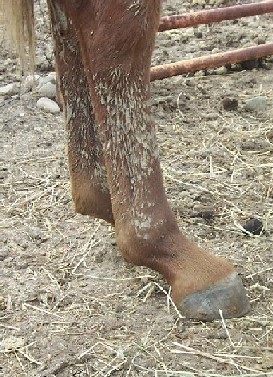Site Menu:
| This is an archived Horseadvice.com Discussion. The parent article and menus are available on the navigation menu below: |
| HorseAdvice.com » Diseases of Horses » Lameness » Joint, Bone, Ligament Diseases » Epiphysitis, Physitis, and Physeal Dysplasia » |
| Discussion on 18 month old Swed. Warm Filly with epiphysitis, what next? | |
| Author | Message |
| New Member: Cquack |
Posted on Saturday, Dec 14, 2002 - 8:18 pm: Hello, I just adopted a Swedish Warmblood filly that is 18 months old and was has been diag. with epiphysitis. I will be supplied with her x rays and all other prior medical care. Now for my part what is my first steps to make sure this filly maintains a healthy life style as a broodmare? As far as Vet, Farrier and nutrietion? The owners had her on a Buckeye product and took her off as soon as she was diag. THis occured after her left front leg had a abcess and allot weight along with the Buckeye was placed on her right leg. It is her knee area that is large. Her plates have not closed as of yet and she is already over 15'1 hands.Where do I send out hay out to get a better understanding of feeding grain/supplements to my animals? We have 4 different fields that produce extremely different quality hay. From Alfala to grass. We are located in Michigan. Thanks (I do have a video clip but its to large to attach. |
| Moderator: DrO |
Posted on Sunday, Dec 15, 2002 - 11:34 am: Hello Carrie,Concerning the epiphysitis diagnosis we have an article, the one associated with this forum, that discusses causes and treatment for the disease. Understanding it should give you a leg up on the situation. But other than that you just need to give good care, we have over 500 articles and 10's of thousands of discussions that cover exactly what you have asked about. Start in the care section and usually the more general articles are at the top of the menus and they get more specific as you go down. For having your hay checked call you local county extension office and they can tell you how to sample and where to send the hay. DrO |
| Member: Cquack |
Posted on Saturday, Jan 4, 2003 - 2:10 pm: I am back with two photo's one of her front legs and the other of her rear leg, I do not know what the name of this is for the rear leg, could you give me a insite? Could it have been because of her epiphysitis? Or is this another whole problem in itself? THanks 
|
| Member: Bonita |
Posted on Saturday, Jan 4, 2003 - 3:24 pm: I don't know about the front leg, but that rear foot looks a bit "clubby" to me. |
| Moderator: DrO |
Posted on Sunday, Jan 5, 2003 - 8:15 am: Hello Carrie,It is a little hard to evaluate the front leg picture because the oblique angle. Is this horse toed in? and cow hocked If you will retake some photos taken from directly in front and behind the horse and one from the side with the horse standing square that would help. I agree with Bonita that it appears the yearling suffers from contracted deep digital flexors behind. Carrie my impresion is that the leg conformation of this yearling indicates she is not suitable for breeding but I would like better photos to be sure. DrO |
| Member: Cquack |
Posted on Sunday, Jan 5, 2003 - 6:39 pm: Hello, she was x rayed and diagnosed with epiphysitis thus her crooked legs, she had abcessed on her good leg which made her bare all her weight on the other side, along with improper nutrition. Her knees have just started to fuse. I was more curious about the hind heel, could the effect of the abcess and the Epiphystitis affect her back leg as well? She was not born this way, I have her records from a SWANA show which she scored a 74% as a 6 week old. |
| Member: Bonita |
Posted on Sunday, Jan 5, 2003 - 10:20 pm: Hi Carrie! I hate to be a continuing wet blanket here, but I also breed, & regardless of her scores as a 6-week-old, this type of leg conformation would not be something I would want to take even the slightest chance of duplicating.That rear club foot could be, as Dr. O said, the result of contracted flexor tendons, or it could also be of some other genetic origin. I knew some folks who bred Connemara ponies & had a line that consistently produced youngsters with club feet - usually in the same darn legs - over & over! It was VERY sad!! Why take a chance? |
| Moderator: DrO |
Posted on Monday, Jan 6, 2003 - 5:00 am: Bonita is right again, just because she was born normal does not mean these are not genetic issues. Take the well known example of grey foals that are born a different color. They don't turn grey until later but this is still genetically controlled. I have seen foals from stallions that reliable became club footed as they grew but they were born normal. This can also apply to the epiphysitis problem: a genetic weakness that predisposes to the condition in the growing foal. No one can know what the foals will be like at this time but the risks of more problems is high.DrO |
Horseadvice.com
is The Horseman's Advisor
Helping Thousands of Equestrians, Farriers, and Veterinarians Every Day
All rights reserved, © 1997 -
is The Horseman's Advisor
Helping Thousands of Equestrians, Farriers, and Veterinarians Every Day
All rights reserved, © 1997 -
